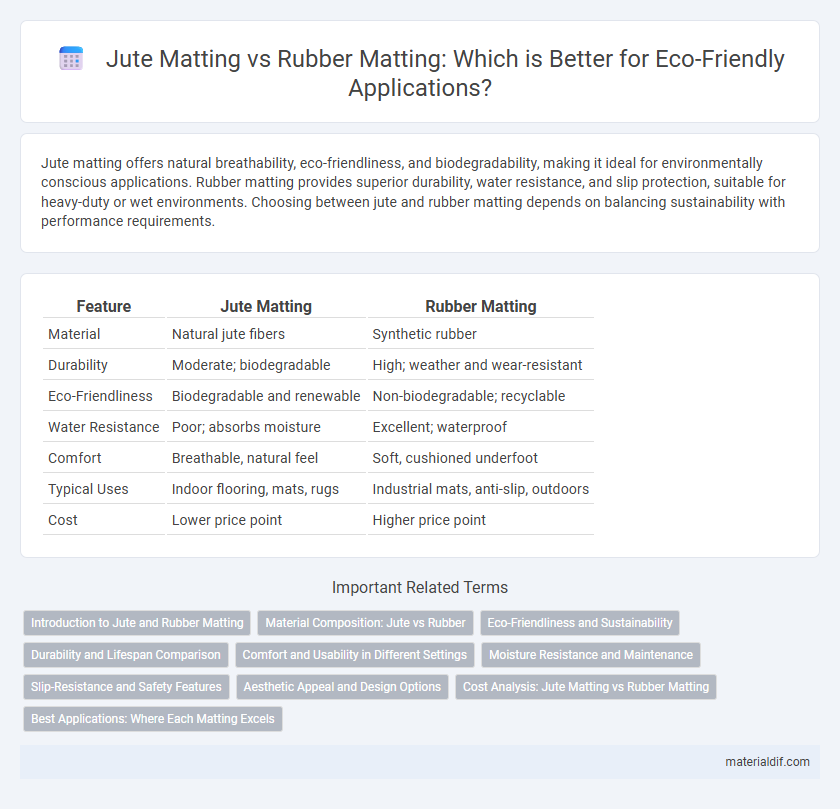Jute matting offers natural breathability, eco-friendliness, and biodegradability, making it ideal for environmentally conscious applications. Rubber matting provides superior durability, water resistance, and slip protection, suitable for heavy-duty or wet environments. Choosing between jute and rubber matting depends on balancing sustainability with performance requirements.
Table of Comparison
| Feature | Jute Matting | Rubber Matting |
|---|---|---|
| Material | Natural jute fibers | Synthetic rubber |
| Durability | Moderate; biodegradable | High; weather and wear-resistant |
| Eco-Friendliness | Biodegradable and renewable | Non-biodegradable; recyclable |
| Water Resistance | Poor; absorbs moisture | Excellent; waterproof |
| Comfort | Breathable, natural feel | Soft, cushioned underfoot |
| Typical Uses | Indoor flooring, mats, rugs | Industrial mats, anti-slip, outdoors |
| Cost | Lower price point | Higher price point |
Introduction to Jute and Rubber Matting
Jute matting, derived from natural jute fibers, offers eco-friendly, biodegradable, and sustainable floor covering solutions known for breathability and moisture-wicking properties. Rubber matting, made from synthetic or recycled rubber, provides durable, slip-resistant surfaces ideal for heavy-duty applications requiring cushioning and impact absorption. Each material's unique attributes cater to diverse needs, with jute emphasizing environmental benefits and rubber focusing on resilience and safety.
Material Composition: Jute vs Rubber
Jute matting is crafted from natural plant fibers derived from the Corchorus plant, offering a biodegradable and eco-friendly option characterized by breathability and moisture-wicking properties. In contrast, rubber matting consists of synthetic or natural rubber compounds that provide durability, water resistance, and high traction but lack biodegradability. The choice between jute and rubber matting depends on the application's requirements for sustainability, flexibility, and environmental impact.
Eco-Friendliness and Sustainability
Jute matting offers superior eco-friendliness due to its natural, biodegradable fibers sourced from renewable jute plants, reducing environmental impact compared to synthetic rubber matting. Rubber matting, often derived from non-renewable petroleum-based materials or vulcanized natural rubber with longer decomposition periods, poses greater sustainability challenges. Choosing jute matting supports sustainable agriculture practices and lowers carbon footprint through its minimal processing and compostable nature, aligning with green living principles.
Durability and Lifespan Comparison
Jute matting offers natural biodegradability with moderate durability, typically lasting 3 to 5 years under regular use, making it ideal for eco-friendly, low-traffic applications. Rubber matting provides superior durability and resilience, often exceeding 10 years of lifespan due to its resistance to wear, moisture, and harsh environmental conditions. Comparing durability, rubber matting is more suitable for high-traffic or industrial environments, while jute matting favors sustainable, lighter-use settings.
Comfort and Usability in Different Settings
Jute matting offers a natural, breathable surface that provides moderate cushioning and excellent moisture absorption, making it ideal for indoor areas like yoga studios and eco-friendly homes. Rubber matting delivers superior cushioning and slip resistance, enhancing comfort and safety in high-traffic or wet environments such as gyms and playgrounds. While jute excels in aesthetic appeal and biodegradability, rubber matting outperforms in durability and ease of cleaning across diverse settings.
Moisture Resistance and Maintenance
Jute matting exhibits limited moisture resistance due to its natural fiber composition, making it susceptible to mold and mildew in damp conditions, whereas rubber matting offers superior water resistance and durability. Maintenance for jute requires regular drying and careful spot cleaning to prevent moisture damage, while rubber mats demand simpler upkeep, often only requiring occasional wiping or hosing down. Choosing rubber matting is ideal for high-moisture environments, whereas jute is better suited for dry, well-ventilated areas to maintain longevity.
Slip-Resistance and Safety Features
Jute matting offers natural slip resistance due to its coarse texture and organic fibers, providing a safe surface ideal for dry areas but may lose effectiveness when wet. Rubber matting features superior slip resistance with its non-slip surface and high grip properties, making it more reliable in wet or oily environments for enhanced safety. Both materials contribute to safety, but rubber matting is preferred for environments requiring consistent slip prevention and durability under moisture exposure.
Aesthetic Appeal and Design Options
Jute matting offers a natural, rustic aesthetic with earthy tones and a textured surface that enhances organic and eco-friendly interior designs. Rubber matting provides a sleek, modern look available in various colors and patterns, catering to contemporary or commercial spaces requiring durability and easy maintenance. Choosing between jute and rubber matting depends on balancing aesthetic preferences with functional design needs.
Cost Analysis: Jute Matting vs Rubber Matting
Jute matting typically costs significantly less than rubber matting due to its natural fiber composition and lower manufacturing expenses. While rubber matting offers superior durability and waterproof properties, its higher price reflects synthetic material processing and enhanced resilience. For budget-sensitive projects prioritizing eco-friendliness, jute matting provides an economical alternative without the premium price associated with rubber products.
Best Applications: Where Each Matting Excels
Jute matting excels in eco-friendly applications such as sustainable flooring, erosion control, and natural landscaping, offering biodegradability and breathability ideal for gardening and indoor use. Rubber matting provides superior durability and slip resistance, making it ideal for high-traffic areas, gyms, industrial settings, and outdoor playgrounds where impact absorption and weather resistance are critical. Choosing between jute and rubber matting depends on prioritizing environmental benefits versus durability and safety performance.
Jute Matting vs Rubber Matting Infographic

 materialdif.com
materialdif.com